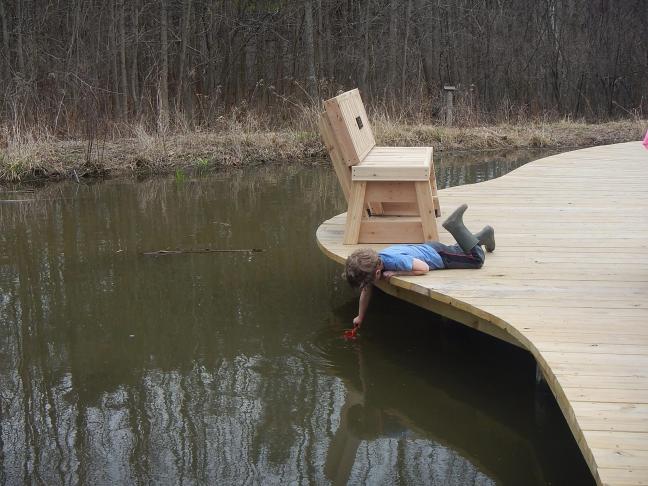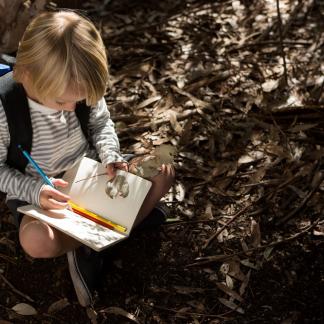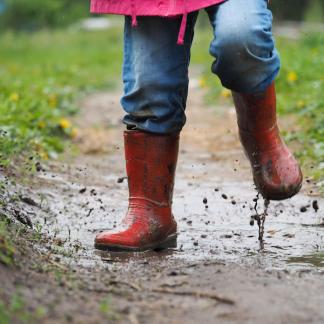My original title for this essay was, “How I Finally Stopped Dreading Transitions and Learned to Love the Between Time.” But it felt a little unwieldy. On the other hand, it sums up fairly well my (newly discovered) belief that it is often the in-between moments, the periods of transition between one activity and the next, the “Between Times,” that are essential to a child’s learning.
Transition times at preschool, I admit, used to aggravate me. It seemed to take so long to gather the children together, count heads, and make sure we had everything - including our gear - before heading off to the woods or prairie. I’m sure we’ve all seen the video of an adorable child trying to gather up a herd of curious kittens. Each time he manages to get one on the blanket, two other ones wander off.

But my feelings about transitions in preschool have changed in recent years. Rather than seeing them as something we have to push through in order to get to the real activity, it has begun to occur to me that perhaps the transition itself is the real activity - or at least is equally valuable. Perhaps learning to change out of muddy socks, gathering up forgotten mittens, and washing hands before snack are as vital to the curriculum as the study of ponds and maple trees - even when it feels a little like kitten herding.
At our Nature Preschool, we have a fair number of transitions in our day, not least of which is the fairly dramatic shift from outdoors to indoors. During certain seasons, there may be a twenty-minute pause in our day as children sit beside their cubbies, wiggling out of soggy rain gear. Our bathrooms may become crammed with water-logged children looking for clean, dry clothes. We could view this muddy interruption as an inconvenience, or we could embrace it. After all, the children are learning self-help skills, they are caring for their immediate needs, and they are given the time and space to do so at an unrushed pace. Snacktime can wait. The story can wait. Those things may be on the lesson plan, but that doesn’t mean they are more important.

I think back to my first year as a teacher and recall my inclination to rush through transitions, always aware of the classroom schedule. Making sure we got all of our activities checked off felt like a measure of success. Not only did I fail to enjoy the disparate “Between Times,” I failed to appreciate their potential. I am sure I caused myself unnecessary stress, along with many of the children as well.
At staff meetings, we will sometimes discuss whether certain transitions can or should be removed from our day. How often do we really need to stop and line up when we explore the trails? Is it okay to begin serving snack for some children while others are still looking for clean, dry socks? I think we all agree that too much waiting around for others, too many stops and starts in a day, can make the routine feel more challenging. We don’t want to spend so much time moving from one activity to the next that the activities themselves feel shorted. Finding value in the “Between Times” does not mean I believe the day should be full of them.
The fact remains that certain transitions are unavoidable: children are shuttled from home to school, from play-tme to group-time, from snack-time to rest-time, field to fen, in one variation or another, in every space and in every program. Some children struggle far more with these daily transitions than others, especially when the change of activity comes at the direction of an adult, rather than of the child’s own volition. The river and dam running the length of the sandbox may not yet be completed. There are still some blocks that need to go on the tower. Not everyone has found their own piece of beach glass.

Gathering up a group of children who are busily engaged in fossil-hunting or chasing the waves on Lake Michigan is never going to be easy. Rather than ploughing through it, reminding the children that it’s a long hike back, or that parents will be coming soon, I’ve learned to see this as a chance to guide the children through the process of ending one thing and beginning another. This is a chance to bid farewell, mindfully, to the lake and the fossils, to find a place of honor for a special rock, to stand together and take a last look at the waves. I now make every effort to walk through these transitions with the children, celebrating small acts of closure, rather than racing ahead of them. I find the movement between our activities to be just as interesting and full of value as the activities themselves.
It is probably unrealistic to think that lining up to go inside will ever be as thrilling as climbing a tree, but it can still be a meaningful part of our day. It can be a time to sing songs, to take a breath, and to gain a deeper understanding that some activities come to an end and we have to adapt to that. For me, transitions no longer feel like the slough between interesting destinations. They have become journeys in their own right.
About the Author




